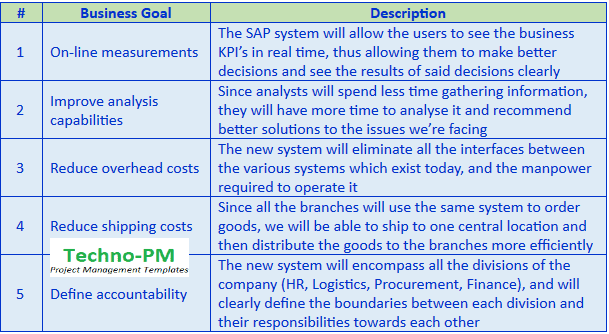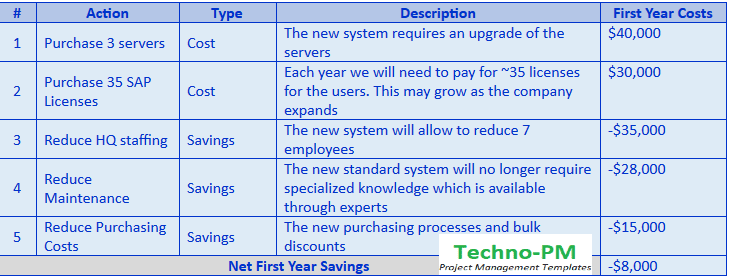Business Case Template
What Is A Business Case?
A good Business Case explains to a company’s’ executive board why they should authorize a new project. Business case outlines the current problem the company is facing and its impact, explains the proposed solution and the benefit it will entail and performs a cost benefit analysis. It may also present alternative solutions, and their benefits.
Based on the business case the stakeholders check whether the proposed project aligns with the company’s strategy, and then approve / deny it. The scope of the business case document differs from company to company, and the rule-of-thumb is that the larger the company, the larger the scope. The following section presents the business case template and business case example for implementing the SAP system in a company. The black font is the template , while the blue font is the example

Business Case Template With Example
Executive Summary
This section is usually a one page summation of the entire document, and presents the bottom line to the stakeholders. The rest of the document allows them to drill down into the details for further explanations. This section is usually written last.
This business case describes how the new SAP system will transform our company from a holdings company to a global one.The Issue –

This section briefly describes what the problem is (but not the solution).
Due to the recent expansion which occurred by our acquisitions in 8 different countries, we now work with 3 different ERP (Enterprise Resource Planning) systems. The result is that we don’t have a common computer language in the company, and this prevents us from using out global presence to receive bulk discounts, lower logistical expenses and shipment tariffs.
The Outcome –
This section outlines the expected outcome and the business benefit.
Transferring to one ERP system will allow our company to implement standard processes, methodologies and systems. This will result in lower expenses, less interfaces between the systems and the ability to measure our company as a whole and not each branch on its own.
The Recommendation -
In this section the approach to solving the business problem is explained.
The approach described in the business case explains how we will meet our objective of continuously improving our efficiency, reducing costs and capitalizing on our global presence. Some of the ways which implementing the SAP system in our company will achieve these goals are
- All our branches will have visibility regarding orders of materials, thus reducing shipping costs and receiving discounts for ordering in bulk.
- We will be able to transfer employees from one branch to another quite easily, since all of them will work with the same processes and systems.
- HQ will be able to measure the company as a whole, and not just each branch on its own.
- The system comes with a BI (Business Intelligence) system, which allows the branch management to easily pinpoint bottlenecks and red flags.
Business Case Analysis Team
This table contains the team members who put the business case together.

Project Overview
This section describes the project in more detail, and includes all the information required to make a go / no-go decision. It includes the goals, assumptions, performance, constraints and major milestones of the project.
Goals -
All the business goals and their description are outlined in the table below.

Performance –
This section aims at ascertaining whether the project succeeded in its objectives by outlining the business measurement which will be used to gauge the goals.

Assumptions –
This section outlines the high level assumptions of the proposed project. This list will most likely grow if the project is approved.
- There will be a 3 week training effort throughout the company on using the new system.
- Funding for the licenses and hardware is available.
- Major stakeholders will support and drive this project forward.
- No system customization will be required.
Constraints –
This section outlines the constraints which may hinder the successful implementation of the proposed project. This list will most likely grow if the project is approved.
- The project will be carried out internally, and no 3rd party vendors will assist.
- 5 new temporary positions will be opened for the sake of this project.
- Phasing out the legacy systems will be met by opposition by the unions.
Major Milestones –
This section presents the major milestones of the project and their deadline dates. This list will grow if the project is approved.

Cost Benefit Analysis
This section is the heart of the business case, and presents its bottom line. Based on this analysis the stakeholders usually approve / deny the go-ahead. It describes the costs and financial benefits (savings) of the project. Of course the desired outcome is that the savings will be more than the costs, but this isn’t necessarily a must (especially in strategic costs). Some of the savings are periodic, while some are one-time only.
The following table describes the net savings for the first year of using the new system –

Bottom Line: The above table comes to the conclusion that the first year of the new system will save our company $8,000.
Approvals
This section requires the approvers to sign their names.




